coolant level Ram ProMaster City 2019 Owner's Manual
[x] Cancel search | Manufacturer: RAM, Model Year: 2019, Model line: ProMaster City, Model: Ram ProMaster City 2019Pages: 348, PDF Size: 3.75 MB
Page 54 of 348
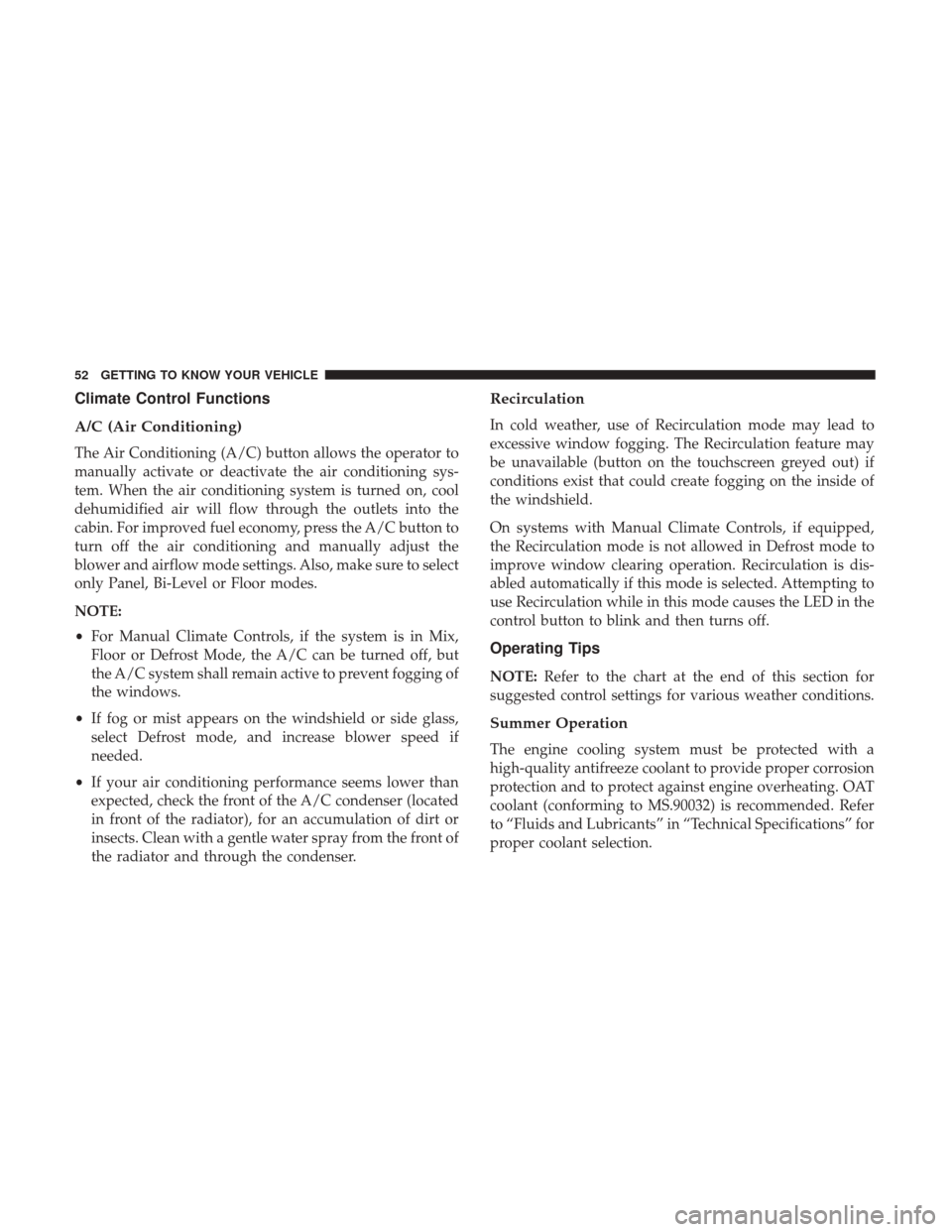
Climate Control Functions
A/C (Air Conditioning)
The Air Conditioning (A/C) button allows the operator to
manually activate or deactivate the air conditioning sys-
tem. When the air conditioning system is turned on, cool
dehumidified air will flow through the outlets into the
cabin. For improved fuel economy, press the A/C button to
turn off the air conditioning and manually adjust the
blower and airflow mode settings. Also, make sure to select
only Panel, Bi-Level or Floor modes.
NOTE:
•For Manual Climate Controls, if the system is in Mix,
Floor or Defrost Mode, the A/C can be turned off, but
the A/C system shall remain active to prevent fogging of
the windows.
• If fog or mist appears on the windshield or side glass,
select Defrost mode, and increase blower speed if
needed.
• If your air conditioning performance seems lower than
expected, check the front of the A/C condenser (located
in front of the radiator), for an accumulation of dirt or
insects. Clean with a gentle water spray from the front of
the radiator and through the condenser.
Recirculation
In cold weather, use of Recirculation mode may lead to
excessive window fogging. The Recirculation feature may
be unavailable (button on the touchscreen greyed out) if
conditions exist that could create fogging on the inside of
the windshield.
On systems with Manual Climate Controls, if equipped,
the Recirculation mode is not allowed in Defrost mode to
improve window clearing operation. Recirculation is dis-
abled automatically if this mode is selected. Attempting to
use Recirculation while in this mode causes the LED in the
control button to blink and then turns off.
Operating Tips
NOTE: Refer to the chart at the end of this section for
suggested control settings for various weather conditions.
Summer Operation
The engine cooling system must be protected with a
high-quality antifreeze coolant to provide proper corrosion
protection and to protect against engine overheating. OAT
coolant (conforming to MS.90032) is recommended. Refer
to “Fluids and Lubricants” in “Technical Specifications” for
proper coolant selection.
52 GETTING TO KNOW YOUR VEHICLE
Page 73 of 348
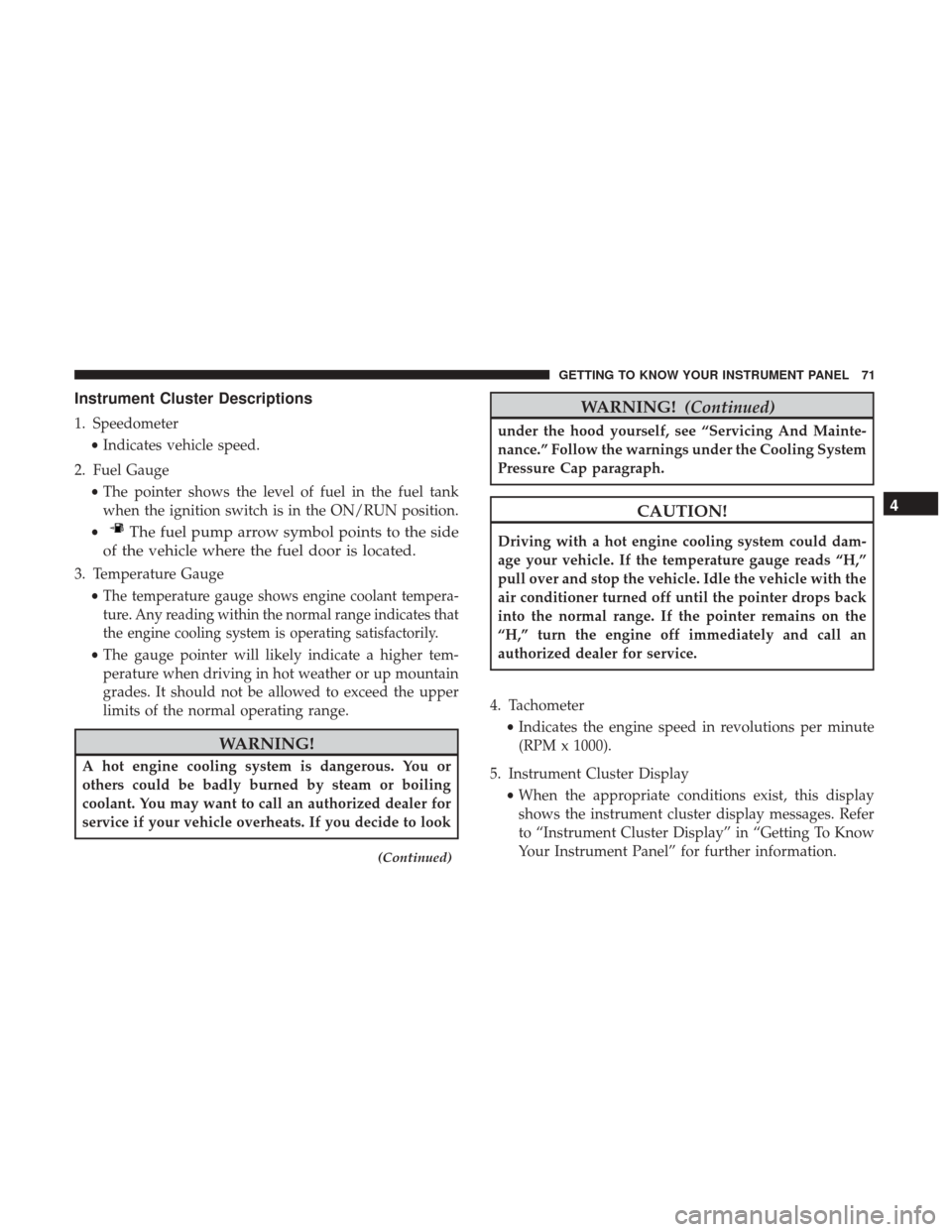
Instrument Cluster Descriptions
1. Speedometer•Indicates vehicle speed.
2. Fuel Gauge •The pointer shows the level of fuel in the fuel tank
when the ignition switch is in the ON/RUN position.
•
The fuel pump arrow symbol points to the side
of the vehicle where the fuel door is located.
3. Temperature Gauge
•
The temperature gauge shows engine coolant tempera-
ture. Any reading within the normal range indicates that
the engine cooling system is operating satisfactorily.
• The gauge pointer will likely indicate a higher tem-
perature when driving in hot weather or up mountain
grades. It should not be allowed to exceed the upper
limits of the normal operating range.
WARNING!
A hot engine cooling system is dangerous. You or
others could be badly burned by steam or boiling
coolant. You may want to call an authorized dealer for
service if your vehicle overheats. If you decide to look
(Continued)
WARNING! (Continued)
under the hood yourself, see “Servicing And Mainte-
nance.” Follow the warnings under the Cooling System
Pressure Cap paragraph.
CAUTION!
Driving with a hot engine cooling system could dam-
age your vehicle. If the temperature gauge reads “H,”
pull over and stop the vehicle. Idle the vehicle with the
air conditioner turned off until the pointer drops back
into the normal range. If the pointer remains on the
“H,” turn the engine off immediately and call an
authorized dealer for service.
4. Tachometer •Indicates the engine speed in revolutions per minute
(RPM x 1000).
5. Instrument Cluster Display •When the appropriate conditions exist, this display
shows the instrument cluster display messages. Refer
to “Instrument Cluster Display” in “Getting To Know
Your Instrument Panel” for further information.
4
GETTING TO KNOW YOUR INSTRUMENT PANEL 71
Page 235 of 348
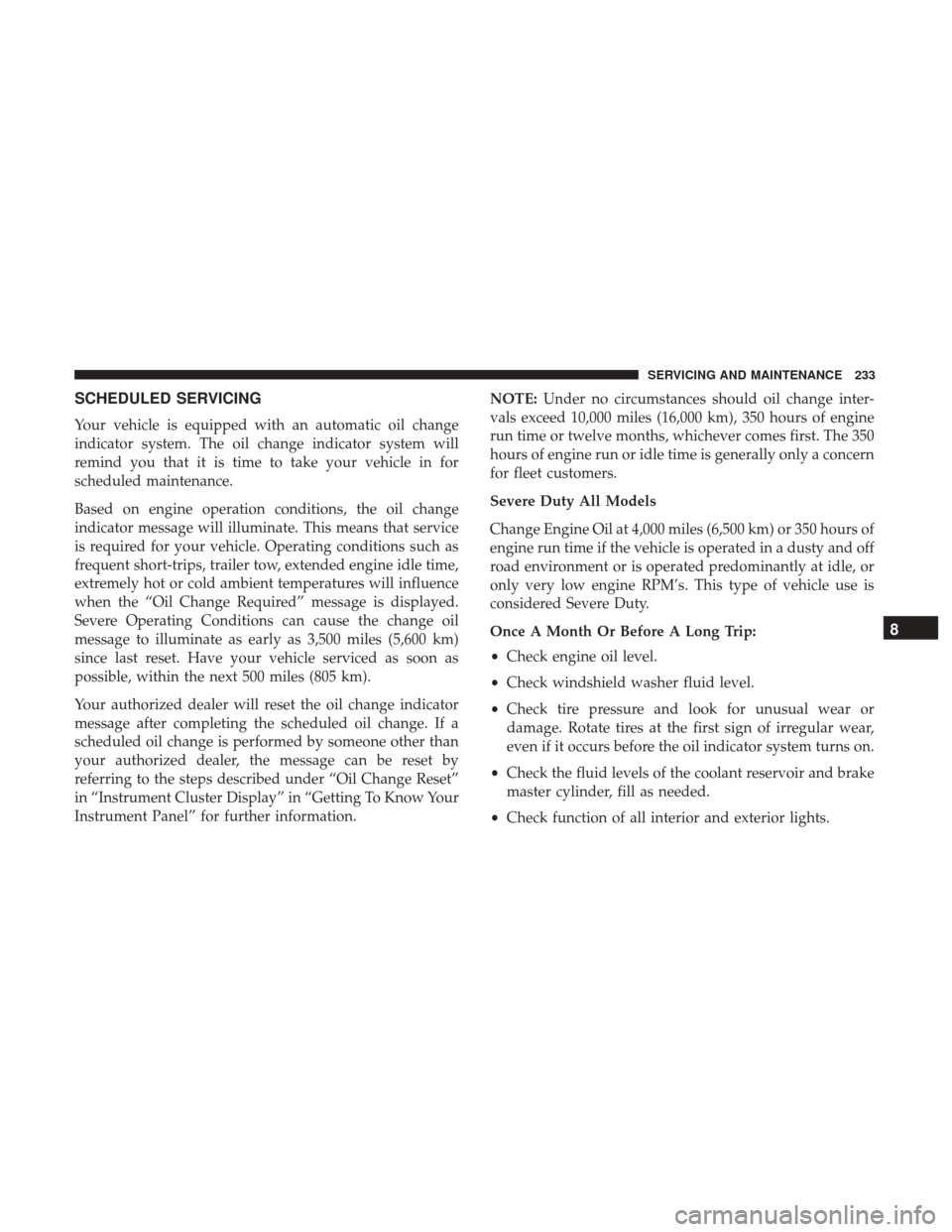
SCHEDULED SERVICING
Your vehicle is equipped with an automatic oil change
indicator system. The oil change indicator system will
remind you that it is time to take your vehicle in for
scheduled maintenance.
Based on engine operation conditions, the oil change
indicator message will illuminate. This means that service
is required for your vehicle. Operating conditions such as
frequent short-trips, trailer tow, extended engine idle time,
extremely hot or cold ambient temperatures will influence
when the “Oil Change Required” message is displayed.
Severe Operating Conditions can cause the change oil
message to illuminate as early as 3,500 miles (5,600 km)
since last reset. Have your vehicle serviced as soon as
possible, within the next 500 miles (805 km).
Your authorized dealer will reset the oil change indicator
message after completing the scheduled oil change. If a
scheduled oil change is performed by someone other than
your authorized dealer, the message can be reset by
referring to the steps described under “Oil Change Reset”
in “Instrument Cluster Display” in “Getting To Know Your
Instrument Panel” for further information.NOTE:
Under no circumstances should oil change inter-
vals exceed 10,000 miles (16,000 km), 350 hours of engine
run time or twelve months, whichever comes first. The 350
hours of engine run or idle time is generally only a concern
for fleet customers.
Severe Duty All Models
Change Engine Oil at 4,000 miles (6,500 km) or 350 hours of
engine run time if the vehicle is operated in a dusty and off
road environment or is operated predominantly at idle, or
only very low engine RPM’s. This type of vehicle use is
considered Severe Duty.
Once A Month Or Before A Long Trip:
• Check engine oil level.
• Check windshield washer fluid level.
• Check tire pressure and look for unusual wear or
damage. Rotate tires at the first sign of irregular wear,
even if it occurs before the oil indicator system turns on.
• Check the fluid levels of the coolant reservoir and brake
master cylinder, fill as needed.
• Check function of all interior and exterior lights.
8
SERVICING AND MAINTENANCE 233
Page 250 of 348
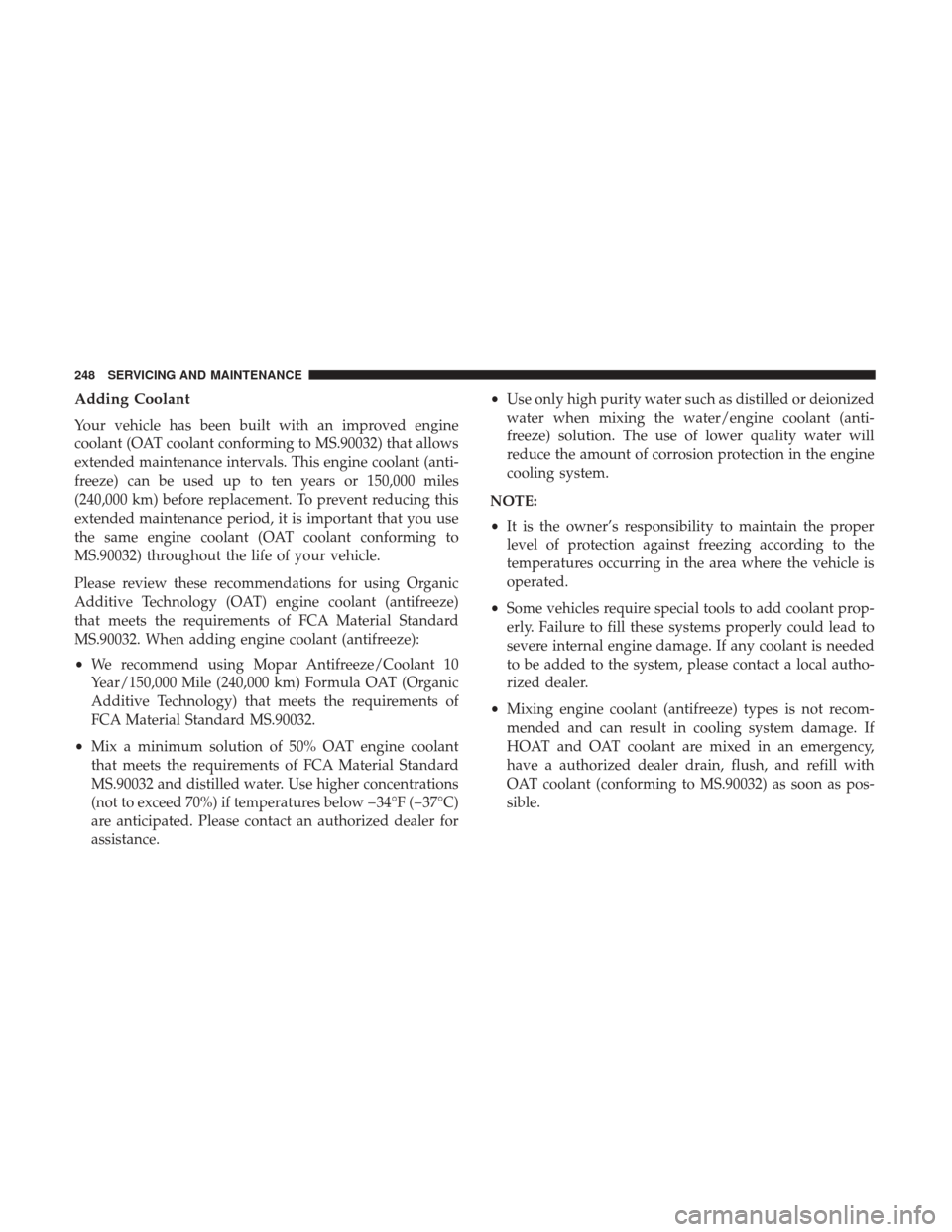
Adding Coolant
Your vehicle has been built with an improved engine
coolant (OAT coolant conforming to MS.90032) that allows
extended maintenance intervals. This engine coolant (anti-
freeze) can be used up to ten years or 150,000 miles
(240,000 km) before replacement. To prevent reducing this
extended maintenance period, it is important that you use
the same engine coolant (OAT coolant conforming to
MS.90032) throughout the life of your vehicle.
Please review these recommendations for using Organic
Additive Technology (OAT) engine coolant (antifreeze)
that meets the requirements of FCA Material Standard
MS.90032. When adding engine coolant (antifreeze):
•We recommend using Mopar Antifreeze/Coolant 10
Year/150,000 Mile (240,000 km) Formula OAT (Organic
Additive Technology) that meets the requirements of
FCA Material Standard MS.90032.
• Mix a minimum solution of 50% OAT engine coolant
that meets the requirements of FCA Material Standard
MS.90032 and distilled water. Use higher concentrations
(not to exceed 70%) if temperatures below �34°F (�37°C)
are anticipated. Please contact an authorized dealer for
assistance. •
Use only high purity water such as distilled or deionized
water when mixing the water/engine coolant (anti-
freeze) solution. The use of lower quality water will
reduce the amount of corrosion protection in the engine
cooling system.
NOTE:
• It is the owner’s responsibility to maintain the proper
level of protection against freezing according to the
temperatures occurring in the area where the vehicle is
operated.
• Some vehicles require special tools to add coolant prop-
erly. Failure to fill these systems properly could lead to
severe internal engine damage. If any coolant is needed
to be added to the system, please contact a local autho-
rized dealer.
• Mixing engine coolant (antifreeze) types is not recom-
mended and can result in cooling system damage. If
HOAT and OAT coolant are mixed in an emergency,
have a authorized dealer drain, flush, and refill with
OAT coolant (conforming to MS.90032) as soon as pos-
sible.
248 SERVICING AND MAINTENANCE
Page 251 of 348
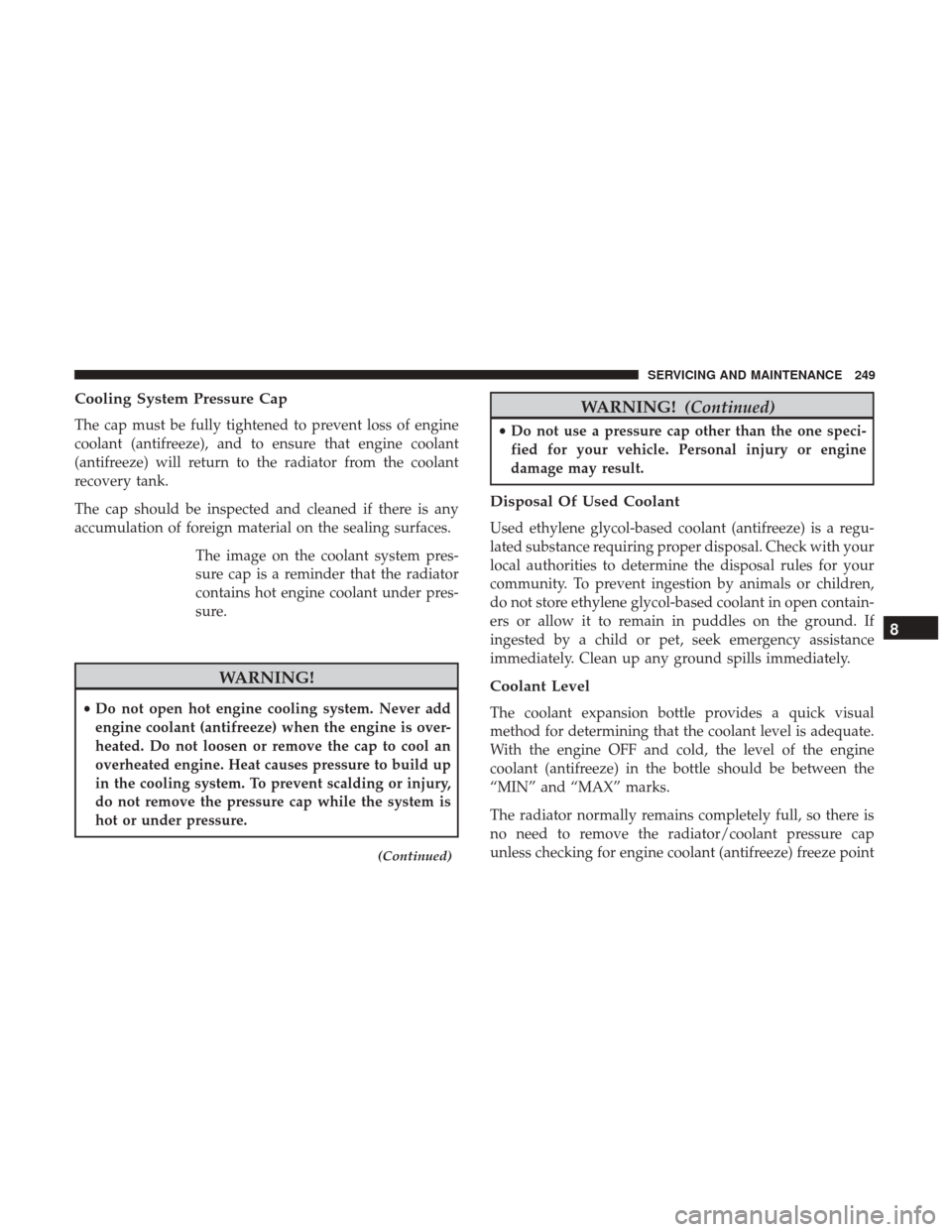
Cooling System Pressure Cap
The cap must be fully tightened to prevent loss of engine
coolant (antifreeze), and to ensure that engine coolant
(antifreeze) will return to the radiator from the coolant
recovery tank.
The cap should be inspected and cleaned if there is any
accumulation of foreign material on the sealing surfaces.The image on the coolant system pres-
sure cap is a reminder that the radiator
contains hot engine coolant under pres-
sure.
WARNING!
•Do not open hot engine cooling system. Never add
engine coolant (antifreeze) when the engine is over-
heated. Do not loosen or remove the cap to cool an
overheated engine. Heat causes pressure to build up
in the cooling system. To prevent scalding or injury,
do not remove the pressure cap while the system is
hot or under pressure.
(Continued)
WARNING! (Continued)
•Do not use a pressure cap other than the one speci-
fied for your vehicle. Personal injury or engine
damage may result.
Disposal Of Used Coolant
Used ethylene glycol-based coolant (antifreeze) is a regu-
lated substance requiring proper disposal. Check with your
local authorities to determine the disposal rules for your
community. To prevent ingestion by animals or children,
do not store ethylene glycol-based coolant in open contain-
ers or allow it to remain in puddles on the ground. If
ingested by a child or pet, seek emergency assistance
immediately. Clean up any ground spills immediately.
Coolant Level
The coolant expansion bottle provides a quick visual
method for determining that the coolant level is adequate.
With the engine OFF and cold, the level of the engine
coolant (antifreeze) in the bottle should be between the
“MIN” and “MAX” marks.
The radiator normally remains completely full, so there is
no need to remove the radiator/coolant pressure cap
unless checking for engine coolant (antifreeze) freeze point
8
SERVICING AND MAINTENANCE 249
Page 252 of 348
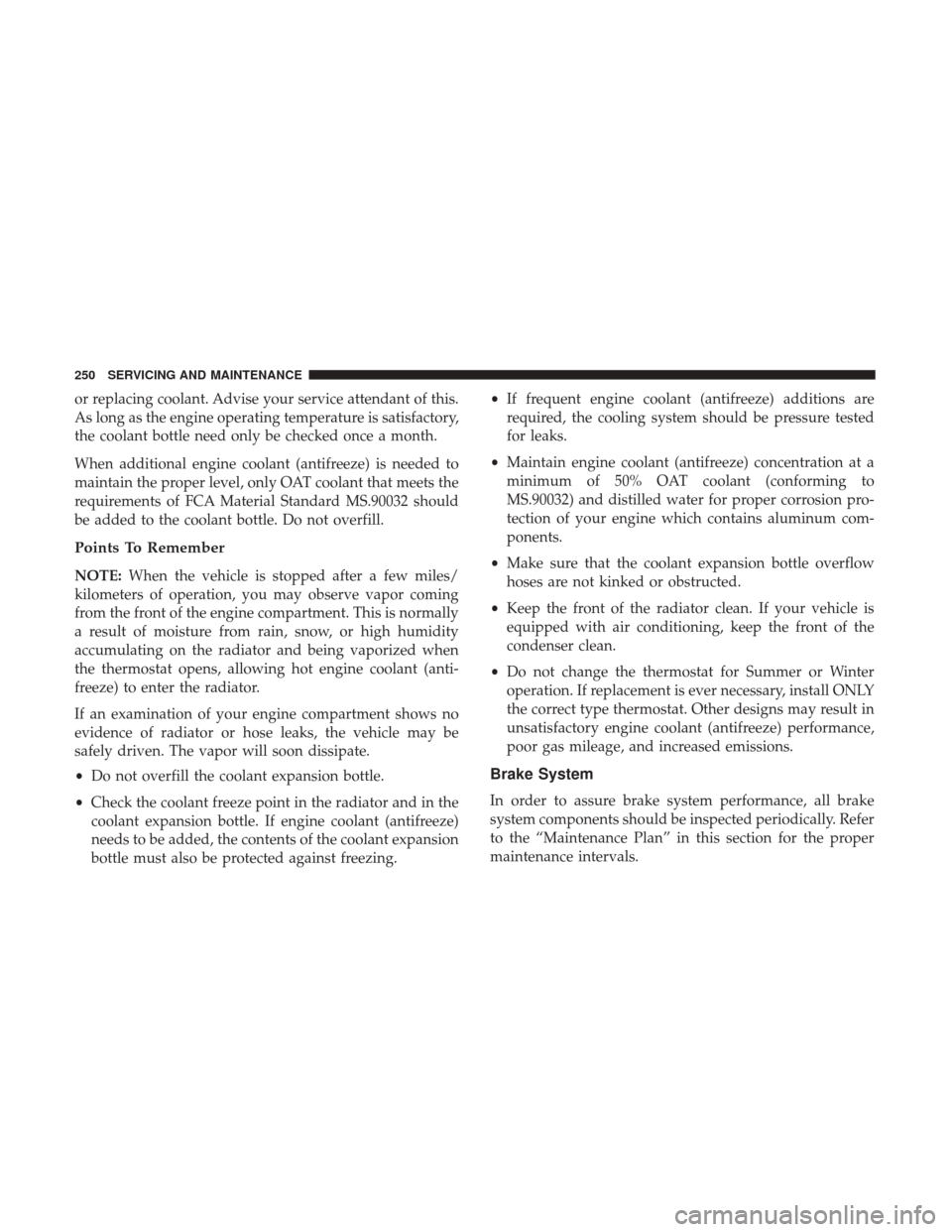
or replacing coolant. Advise your service attendant of this.
As long as the engine operating temperature is satisfactory,
the coolant bottle need only be checked once a month.
When additional engine coolant (antifreeze) is needed to
maintain the proper level, only OAT coolant that meets the
requirements of FCA Material Standard MS.90032 should
be added to the coolant bottle. Do not overfill.
Points To Remember
NOTE:When the vehicle is stopped after a few miles/
kilometers of operation, you may observe vapor coming
from the front of the engine compartment. This is normally
a result of moisture from rain, snow, or high humidity
accumulating on the radiator and being vaporized when
the thermostat opens, allowing hot engine coolant (anti-
freeze) to enter the radiator.
If an examination of your engine compartment shows no
evidence of radiator or hose leaks, the vehicle may be
safely driven. The vapor will soon dissipate.
• Do not overfill the coolant expansion bottle.
• Check the coolant freeze point in the radiator and in the
coolant expansion bottle. If engine coolant (antifreeze)
needs to be added, the contents of the coolant expansion
bottle must also be protected against freezing. •
If frequent engine coolant (antifreeze) additions are
required, the cooling system should be pressure tested
for leaks.
• Maintain engine coolant (antifreeze) concentration at a
minimum of 50% OAT coolant (conforming to
MS.90032) and distilled water for proper corrosion pro-
tection of your engine which contains aluminum com-
ponents.
• Make sure that the coolant expansion bottle overflow
hoses are not kinked or obstructed.
• Keep the front of the radiator clean. If your vehicle is
equipped with air conditioning, keep the front of the
condenser clean.
• Do not change the thermostat for Summer or Winter
operation. If replacement is ever necessary, install ONLY
the correct type thermostat. Other designs may result in
unsatisfactory engine coolant (antifreeze) performance,
poor gas mileage, and increased emissions.
Brake System
In order to assure brake system performance, all brake
system components should be inspected periodically. Refer
to the “Maintenance Plan” in this section for the proper
maintenance intervals.
250 SERVICING AND MAINTENANCE
Page 294 of 348
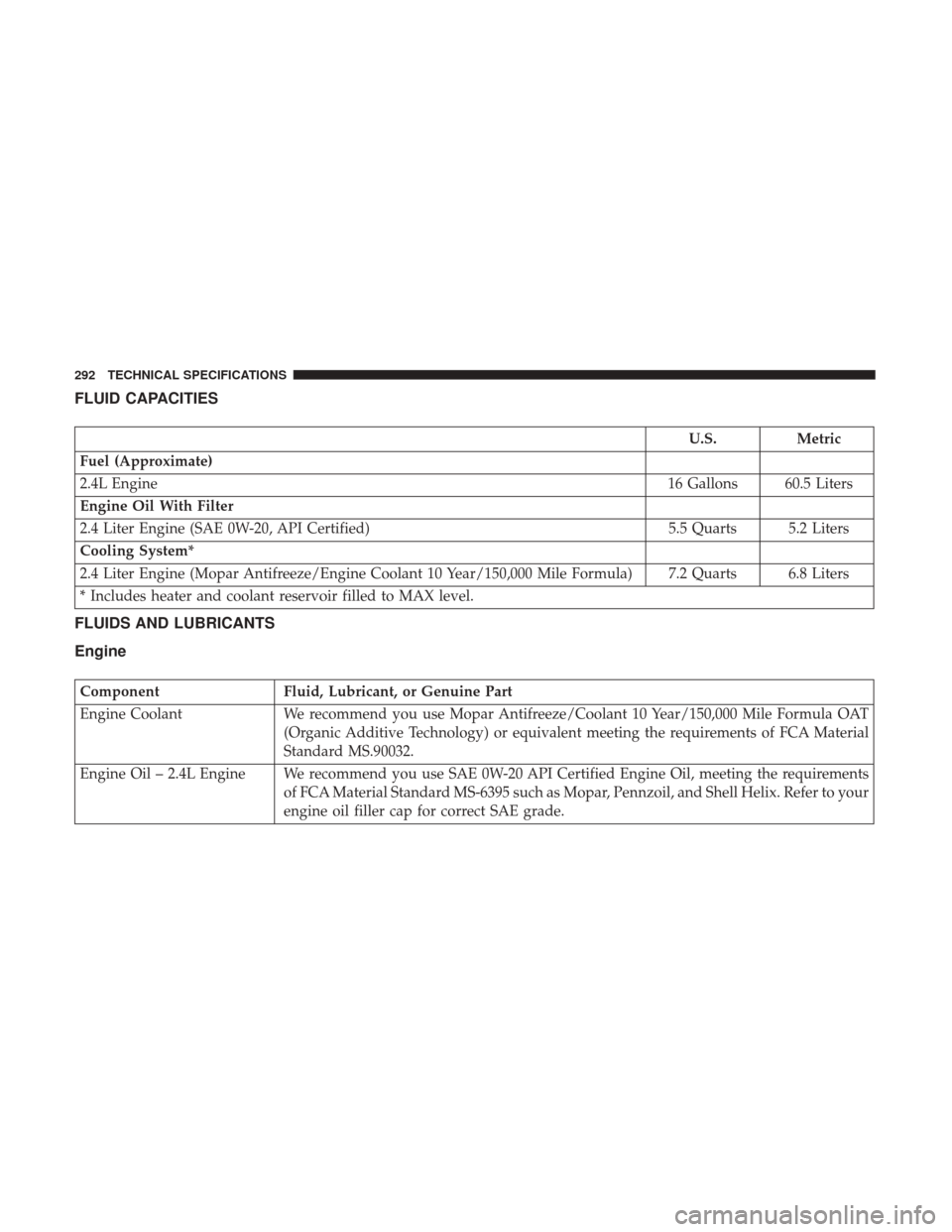
FLUID CAPACITIES
U.S.Metric
Fuel (Approximate)
2.4L Engine 16 Gallons 60.5 Liters
Engine Oil With Filter
2.4 Liter Engine (SAE 0W-20, API Certified) 5.5 Quarts 5.2 Liters
Cooling System*
2.4 Liter Engine (Mopar Antifreeze/Engine Coolant 10 Year/150,000 Mile Formula) 7.2 Quarts 6.8 Liters
* Includes heater and coolant reservoir filled to MAX level.
FLUIDS AND LUBRICANTS
Engine
Component Fluid, Lubricant, or Genuine Part
Engine Coolant We recommend you use Mopar Antifreeze/Coolant 10 Year/150,000 Mile Formula OAT
(Organic Additive Technology) or equivalent meeting the requirements of FCA Material
Standard MS.90032.
Engine Oil – 2.4L Engine We recommend you use SAE 0W-20 API Certified Engine Oil, meeting the requirements of FCA Material Standard MS-6395 such as Mopar, Pennzoil, and Shell Helix. Refer to your
engine oil filler cap for correct SAE grade.
292 TECHNICAL SPECIFICATIONS
Page 328 of 348
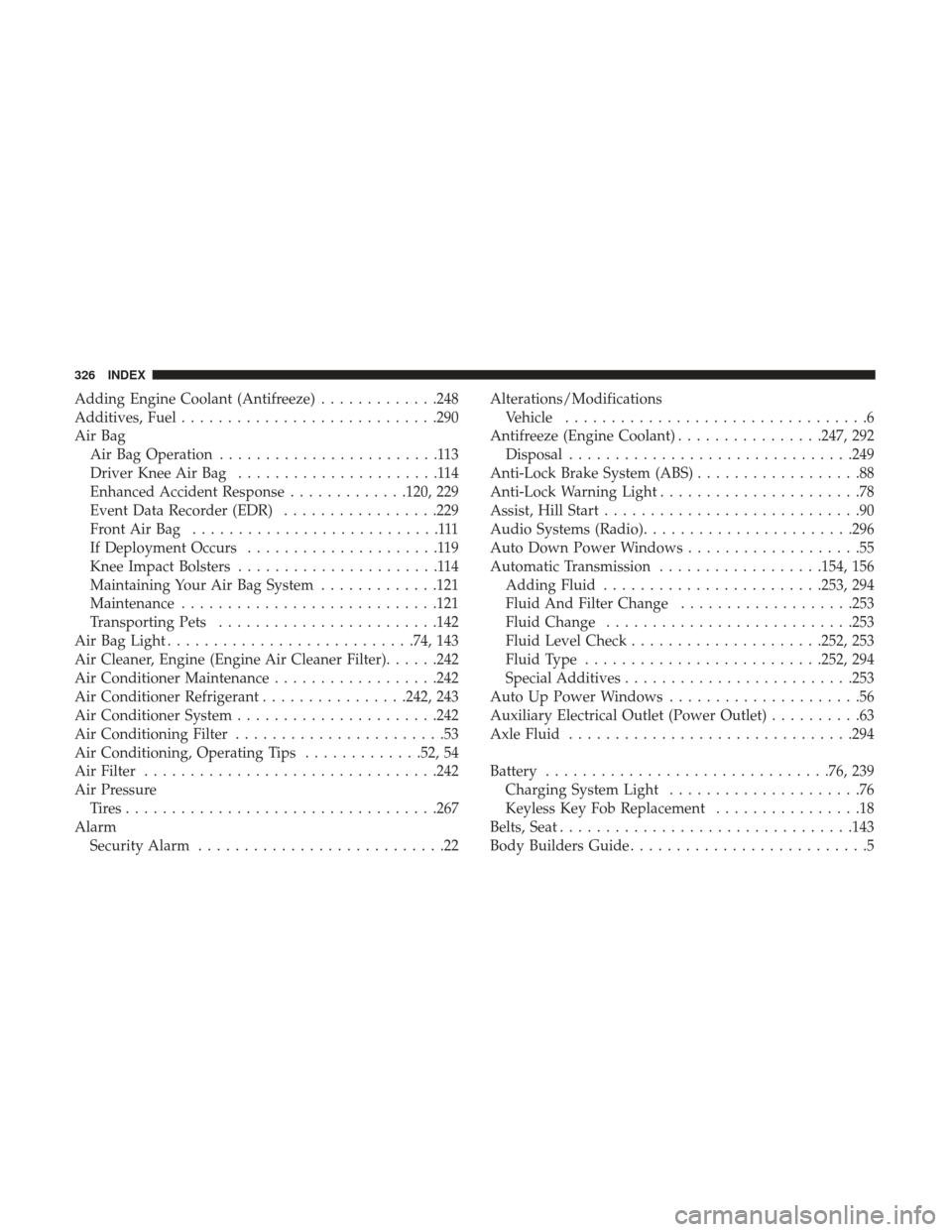
Adding Engine Coolant (Antifreeze).............248
Additives, Fuel ........................... .290
Air Bag Air Bag Operation ........................113
Driver Knee Air Bag ......................114
Enhanced Accident Response .............120, 229
Event Data Recorder (EDR) .................229
FrontAirBag ...........................111
If Deployment Occurs .....................119
Knee Impact Bolsters ......................114
Maintaining Your Air Bag System .............121
Maintenance ........................... .121
Transporting Pets ....................... .142
Air Bag Light .......................... .74, 143
Air Cleaner, Engine (Engine Air Cleaner Filter) ......242
Air Conditioner Maintenance ..................242
Air Conditioner Refrigerant ................242, 243
Air Conditioner System ..................... .242
Air Conditioning Filter .......................53
Air Conditioning, Operating Tips .............52, 54
Air Filter ............................... .242
Air Pressure Tires................................. .267
Alarm Security Alarm ...........................22 Alterations/Modifications
Vehicle .................................6
Antifreeze (Engine Coolant) ................247, 292
Disposal .............................. .249
Anti-Lock Brake System (ABS) ..................88
Anti-Lock Warning Light ......................78
Assist, Hill Start ............................90
Audio Systems (Radio) ...................... .296
Auto Down Power Windows ...................55
Automatic Transmission ..................154, 156
Adding Fluid ....................... .253, 294
Fluid And Filter Change ...................253
Fluid Change .......................... .253
Fluid Level Check .....................252, 253
Fluid Type ......................... .252, 294
Special Additives ........................ .253
Auto Up Power Windows .....................56
Auxiliary
Electrical Outlet (Power Outlet) ..........63
Axle Fluid .............................. .294
Battery .............................. .76, 239
Charging System Light .....................76
Keyless Key Fob Replacement ................18
Belts, Seat ............................... .143
Body Builders Guide ..........................5
326 INDEX
Page 330 of 348
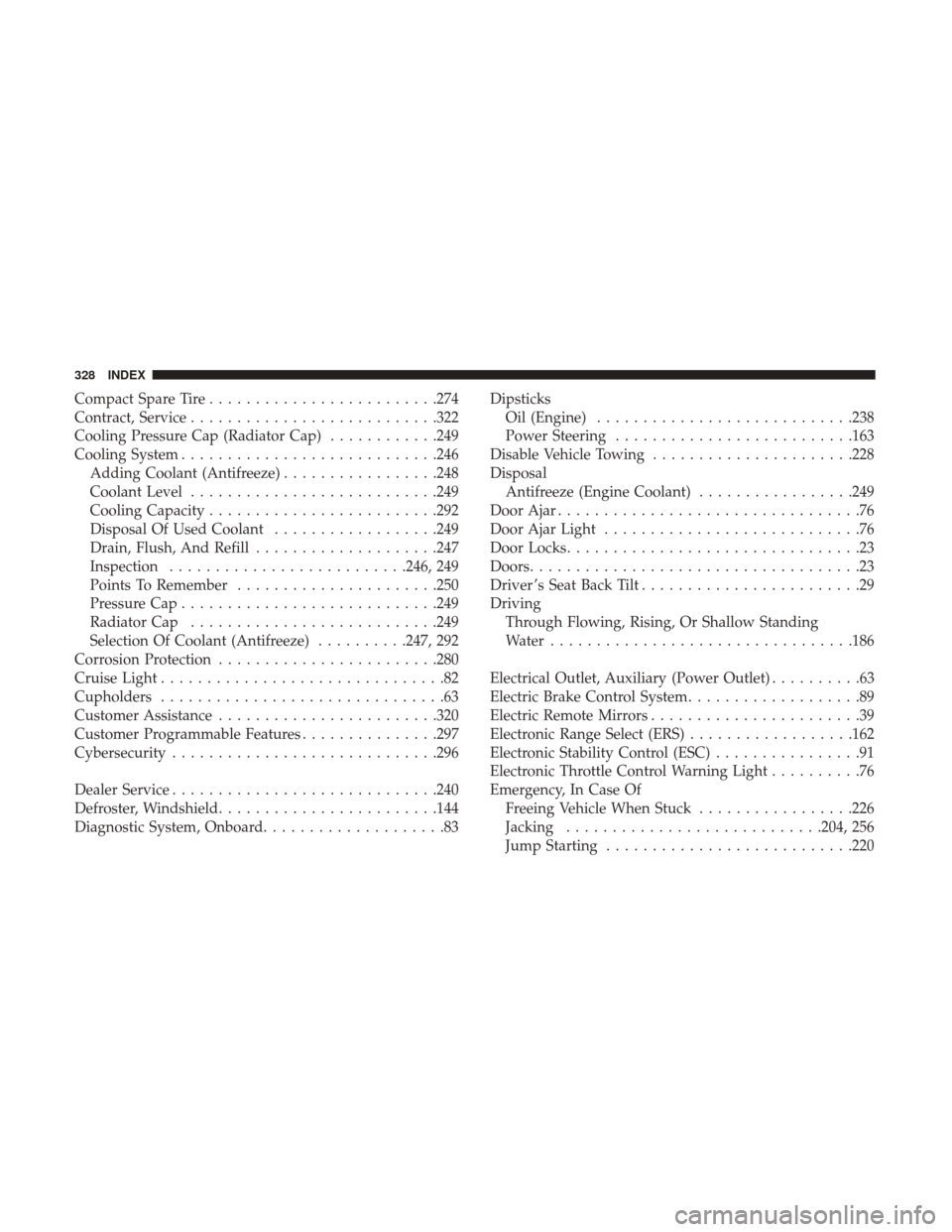
Compact Spare Tire........................ .274
Contract, Service .......................... .322
Cooling Pressure Cap (Radiator Cap) ............249
Cooling System ........................... .246
Adding Coolant (Antifreeze) .................248
Coolant Level .......................... .249
Cooling Capacity ........................ .292
Disposal Of Used Coolant ..................249
Drain, Flush, And Refill ....................247
Inspection ......................... .246, 249
Points To Remember ..................... .250
Pressure Cap ........................... .249
Radiator Cap .......................... .249
Selection Of Coolant (Antifreeze) ..........247, 292
Corrosion Protection ....................... .280
Cruise Light ...............................82
Cupholders ...............................63
Customer Assistance ....................... .320
Customer Programmable Features ...............297
Cybersecurity ............................ .296
Dealer Service ............................ .240
Defroster, Windshield ....................... .144
Diagnostic System, Onboard ....................83 Dipsticks
Oil (Engine) ........................... .238
Power Steering ......................... .163
Disable Vehicle Towing ..................... .228
Disposal Antifreeze (Engine Coolant) .................249
Door Ajar .................................76
Door Ajar Light ............................76
Door Locks ................................23
Doors ....................................23
Driver ’s Seat Back Tilt ........................29
Driving Through Flowing, Rising, Or Shallow Standing
Water ................................ .186
Electrical Outlet, Auxiliary (Power Outlet) ..........63
Electric Brake Control System ...................89
Electric Remote Mirrors .......................39
Electronic Range Select (ERS )..................162
Electr
onic Stability Control (ESC) ................91
Electronic Throttle Control Warning Light ..........76
Emergency, In Case Of Freeing Vehicle When Stuck .................226
Jacking ........................... .204, 256
Jump Starting .......................... .220
328 INDEX
Page 331 of 348
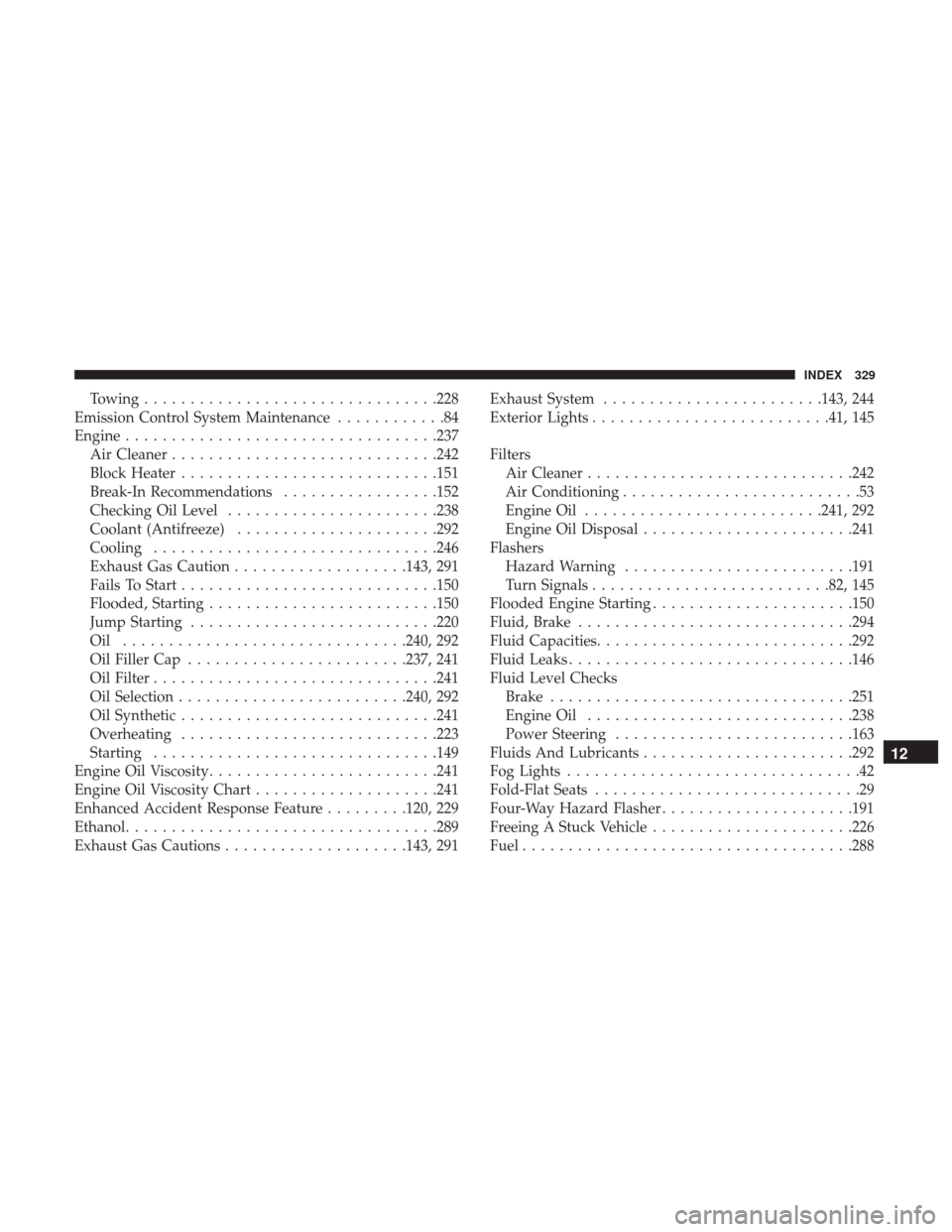
Towing............................... .228
Emission Control System Maintenance ............84
Engine ................................. .237
Air Cleaner ............................ .242
Block Heater ........................... .151
Break-In Recommendations .................152
Checking Oil Level ...................... .238
Coolant (Antifreeze) ..................... .292
Cooling .............................. .246
Exhaust Gas Caution ...................143, 291
Fails To Start ........................... .150
Flooded, Starting ........................ .150
Jump Starting .......................... .220
Oil .............................. .240, 292
Oil Filler Cap ....................... .237, 241
Oil Filter .............................. .241
Oil Selection ........................ .240, 292
Oil Synthetic ........................... .241
Overheating ........................... .223
Starting .............................. .149
Engine Oil Viscosity ........................ .241
Engine Oil Viscosity Chart ....................241
Enhanced Accident Response Feature .........120, 229
Ethanol ................................. .289
Exhaust Gas Cautions ....................143, 291 Exhaust System
....................... .143, 244
Exterior Lights ......................... .41, 145
Filters Air Cleaner ............................ .242
Air Conditioning ..........................53
Engine Oil ......................... .241, 292
Engine Oil Disposal ...................... .241
Flashers Hazard Warning ........................ .191
Turn Signals ......................... .82, 145
Flooded Engine Starting ..................... .150
Fluid, Brake ............................. .294
Fluid
Capacities ........................... .292
Fluid Leaks .............................. .146
Fluid Level Checks Brake ................................ .251
Engine Oil ............................ .238
Power Steering ......................... .163
Fluids And Lubricants ...................... .292
Fog Lights ................................42
Fold-Flat Seats .............................29
Four-Way Hazard Flasher .....................191
Freeing A Stuck Vehicle ..................... .226
Fuel ................................... .288
12
INDEX 329